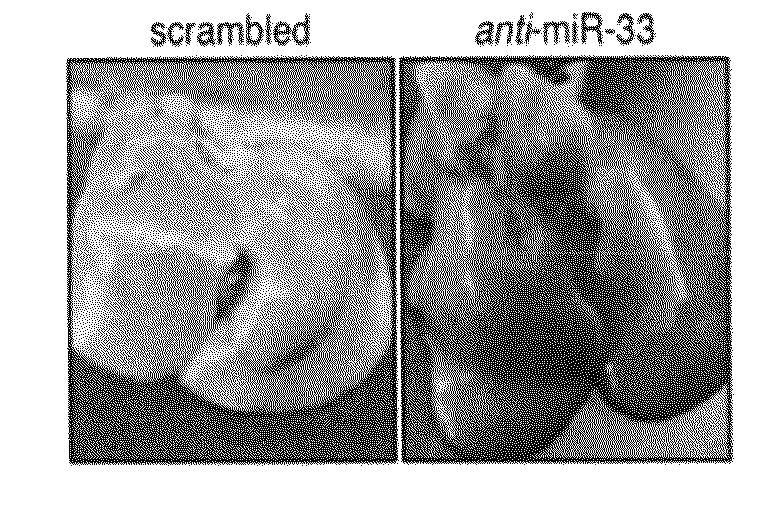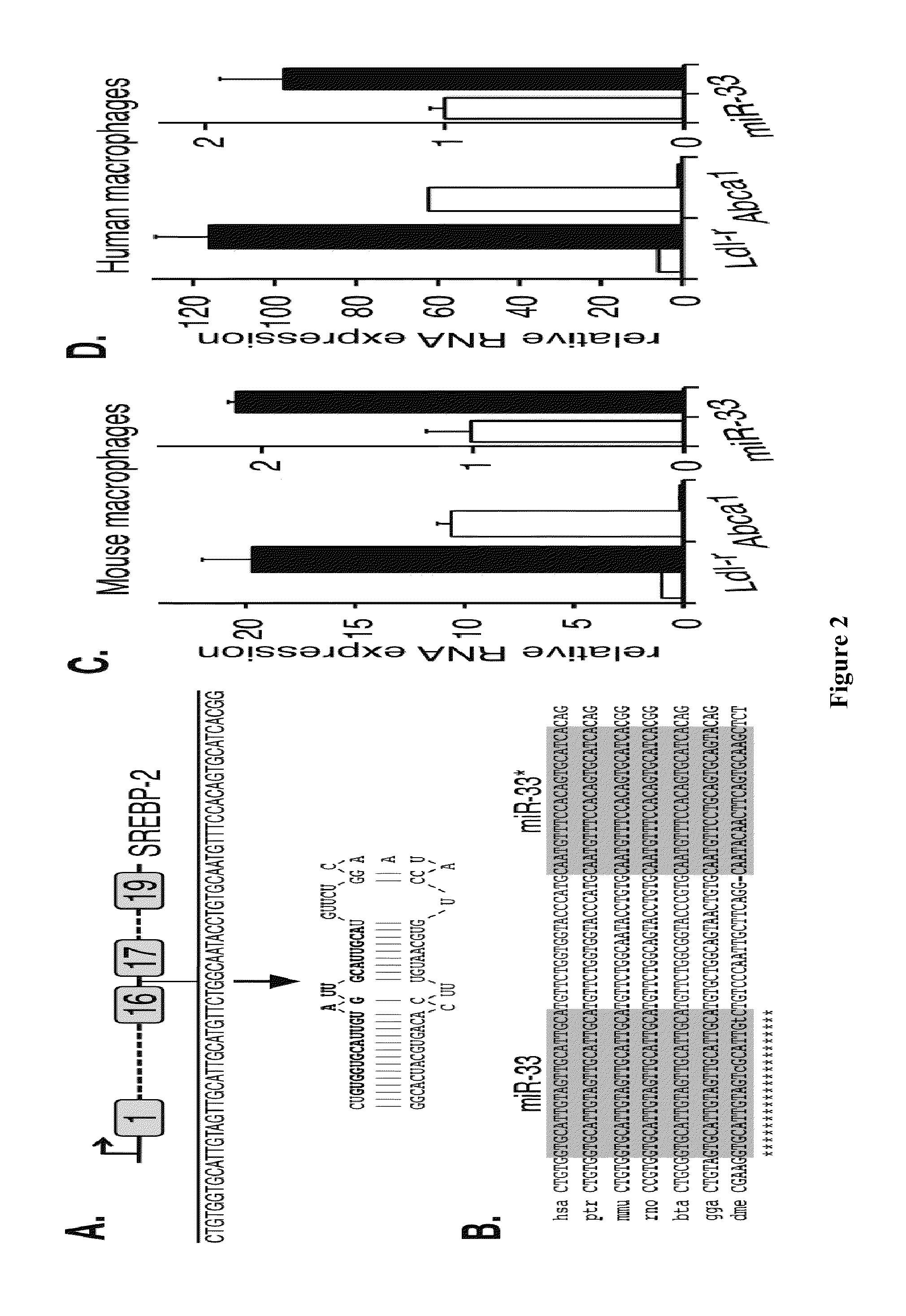Methods and compositions for the management of cardiovascular disease with oligonucleotides
a technology of oligonucleotides and compositions, applied in the direction of drug compositions, cardiovascular disorders, muscular disorders, etc., can solve the problems of statin administration, adverse side effects or statin induced secondary effects, and patients with a low hdl/ldl ratio at increased risk of heart diseas
- Summary
- Abstract
- Description
- Claims
- Application Information
AI Technical Summary
Benefits of technology
Problems solved by technology
Method used
Image
Examples
example 1
[0091]Expression of miR-33. In an attempt to identify miRNAs that might affect cholesterol homeostasis, in silico analysis were performed of human genes encoding nuclear receptors and transcription factors that were known to affect lipid homeostasis. The analysis identified sequences corresponding to miR-33 within intron 16 of human Srebp-2 (FIG. 2A). Importantly, these sequences are conserved across multiple animal species (FIG. 2B). To test the hypothesis that Srebp-2 and miR-33 are co-expressed and regulated by the same metabolic / sterol stimuli, mouse and human primary macrophages were incubated in media containing low or high sterols (see Methods), conditions that are known to regulate Srebp-2, SREBP-2 target genes and LXR target genes (Brown, and Goldstein, (1997) Cell; 89:331; Venkateswaran et al., (2000) Proc Natl Acad Sci USA; 97:12097). As expected, excess exogenous cholesterol resulted in increased expression of the LXR target genes Abca1 and Abcg1, with concomitant repres...
example 2
[0092]miR-33 repression of LXR targeted Genes. Since SREBP-2 and LXR control antagonistic aspects of cellular sterol homeostasis, it was demonstrated that miR-33 was involved in repression of LXR target genes, such as ABCA1 and ABCG1 that are known to promote the efflux of cholesterol from cells. Analysis of the 3′-UTR regions of ABCA1 and ABCG1 identified sequences in both genes that are partially complementary to miR-33 sequences (FIGS. 3A, B, and C). In the case of human ABCA1, a proximal element at nucleotides 120-172 downstream of the stop codon was identified that contained three overlapping putative miR-33 responsive elements, and was termed Box 1. Also, a distal element at nucleotides 1,465-1,481 after the stop codon was identified and termed Box 2 (FIGS. 3A and C). For human ABCG1, a single putative miR-33 response element was identified at nucleotides 516-541 after the stop codon (FIGS. 33 and C). The same putative sequences were found in nucleotides 120-171 and 1,426-1,44...
example 3
[0094]miR-33 modulation of cellular sterol homeostasis. It was demonstrated that miR-33-dependent repression of ABCA1 and / or ABCG1 could affect cellular sterol homeostasis in vitro and in vivo. To demonstrate that miR-33 modulates the efflux of cellular cholesterol, HEK293 cells were transfected with scrambled or anti-miR-33 oligonucleotides (Dharmacon) and then incubated the with [3H]-cholesterol in the presence or absence of ligands for LXR and RXR to induce ABCA1 and ABCG1. The ability of the cells to efflux the radiolabeled sterol to BSA, ApoAI and FBS was analyzed 6 h later (FIG. 4). Following activation of LXR:RXR, silencing of miR-33 resulted in enhanced cholesterol efflux to ApoAI or FBS (FIG. 4A, compare lanes 5-6 to 7-8; and 9-10 to 11-12). Thus, mir-33 silencing increases the ability of cells to efflux cholesterol. These data offer a molecular explanation to previously reported studies showing that treatment with Statins, which induce Srebp-2, resulted in decreased expres...
PUM
| Property | Measurement | Unit |
|---|---|---|
| Transport properties | aaaaa | aaaaa |
Abstract
Description
Claims
Application Information
 Login to View More
Login to View More - R&D
- Intellectual Property
- Life Sciences
- Materials
- Tech Scout
- Unparalleled Data Quality
- Higher Quality Content
- 60% Fewer Hallucinations
Browse by: Latest US Patents, China's latest patents, Technical Efficacy Thesaurus, Application Domain, Technology Topic, Popular Technical Reports.
© 2025 PatSnap. All rights reserved.Legal|Privacy policy|Modern Slavery Act Transparency Statement|Sitemap|About US| Contact US: help@patsnap.com



